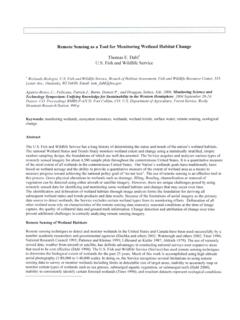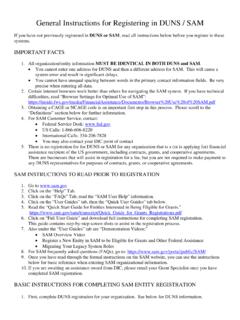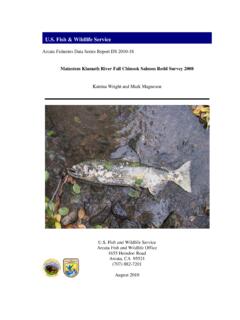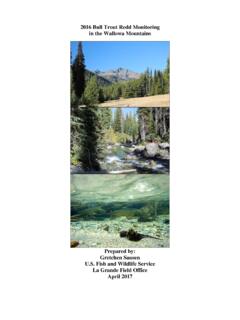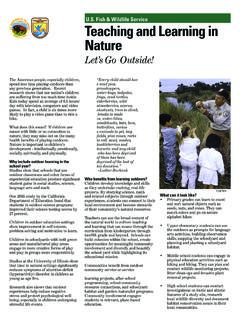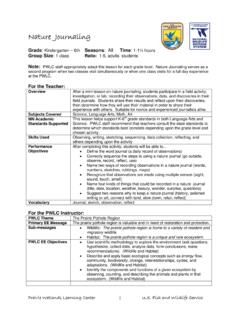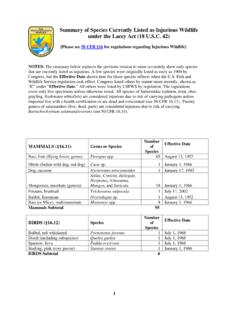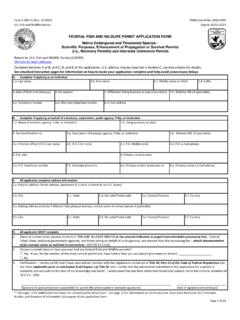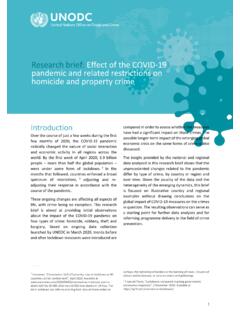Transcription of Why Save Endangered Species? - FWS
1 Why Save Endangered Species? Fish & Wildlife ServiceSince life began on Earth, countless creatures have come and gone, rendered extinct by naturally changing physical and biological extinction is part of the natural order, and if many other species remain, some people ask: Why save Endangered species? Why should we spend money and effort to conserve them? How do we benefit? Congress answered these questions in the preamble to the Endangered Species Act of 1973, recognizing that Endangered and threatened species of wildlife and plants are of esthetic, ecological, educational, historical, recreational, and scientific value to the Nation and its people. In this statement, Congress summarized convincing arguments made by scientists, conservationists, and others who are concerned by the disappearance of unique creatures.
2 Congress further stated its intent that the Act should conserve the ecosystems upon which Endangered and threatened species extinctions occur naturally, scientific evidence strongly indicates that the current rate of extinction is much higher than the natural or background rate of the past. The main force driving this higher rate of loss is habitat loss. Over-exploitation of wildlife for commercial purposes, the introduction of harmful exotic (nonnative) organisms, environmental pollution, and the spread of diseases also pose serious threats to our world s biological pigeons once numbered in the billions but now exist only in Clark/Smithsonian InstitutionConservation actions carried out in the United States under the Endangered Species Act have been successful in preventing extinction for 99 percent of the species that are listed as Endangered or threatened.
3 However, species loss on a global scale continues to increase due to the environmental effects of human activities. Biologists estimate that since the Pilgrims landed at Plymouth Rock in 1620, more than 500 species, subspecies, and varieties of our Nation s plants and animals have become extinct. The situation in Earth s most biologically rich ecosystems is even worse. Tropical rainforests around the world, which may contain up to one half of all living species, are losing millions of acres every year. Uncounted species are lost as these habitats are destroyed. In short, there is nothing natural about today s rate of : Former rainforest habitatBelow: Intact rainforest at dawnCIACECB/BU Photo LibraryNot too long ago, almost one quarter of the trees in the Appalachian forests were American chestnuts.
4 They helped support not only wildlife but the people living among them. Chestnuts were an important cash crop for many families. As year-end holidays approached, nuts by the railroad car were sold and shipped to northeastern cities. Chestnut timber, strong and rot resistant, was prized for building barns, fences, furniture, and other products. This photograph of the Shelton family, taken around 1920, shows the size American chestnut trees once detected in 1904, an Asian fungus to which native chestnuts had little resistance appeared in New York City trees. The blight spread quickly, and by 1950 the American chestnut was virtually extinct except for occasional root sprouts that also became infected.
5 Organizations such as the American Chestnut Foundation are working with plant breeders to develop a disease resistant strain and restore it to the eastern of Great Smoky Mountains National Park and the American Chestnut FoundationBenefits of Natural DiversityHow many species of plants and animals are there? Although scientists have classified approximately million organisms, they recognize that the overwhelming majority have not yet been catalogued. Between 10 and 50 million species may inhabit our of these creatures exists in a vacuum. All living things are part of a complex, often delicately balanced network called the biosphere. The earth s biosphere, in turn, is composed of countless ecosystems, which include plants and animals and their physical environments.
6 No one knows how the extinction of organisms will affect the other members of its ecosystem, but the removal of a single species can set off a chain reaction affecting many others. This is especially true for keystone species, whose loss can transform or undermine the ecological processes or fundamentally change the species composition of the wildlife Mountain hedgehog Don KurzThe gray wolf is one such keystone species. When wolves were restored to Yellowstone National Park, they started to control the park s large population of elk, which had been over consuming the willows, aspen, and other trees that grew along streams. The recovery of these trees is cooling stream flows, which benefits native trout, and increases nesting habitat for migratory birds.
7 Beavers now have willow branches to eat, and beaver dams create marshland habitat for otters, mink, and ducks. Wolves even benefit the threatened grizzly bear, since grizzlies find it easier to take over a wolf kill than to bring down their own to MedicineOne of the many tangible benefits of biological diversity has been its contributions to the field of medicine. Each living thing contains a unique reservoir of genetic material that has evolved over eons. This material cannot be retrieved or duplicated if lost. So far, scientists have investigated only a small fraction of the world s species and have just begun to unravel their chemical secrets to find possible human health benefits to BrooksGray wolfNo matter how small or obscure a species, it could one day be of direct importance to us all.
8 It was only a fungus that gave us penicillin, and certain plants have yielded substances used in drugs to treat heart disease, cancer, and a variety of other illnesses. More than a quarter of all prescriptions written annually in the United States contain chemicals discovered in plants and animals. If these organisms had been destroyed before their unique chemistries were known, their secrets would have died with few hundred wild species have stocked our pharmacies with antibiotics, anti-cancer agents, pain killers, and blood thinners. The biochemistry of unexamined species is an unfathomed reservoir of new and potentially more effective substances. The reason is found in the principles of evolutionary biology.
9 Caught in an endless arms race with other forms of life, these species have devised myriad ways to combat microbes and cancer-causing runaway cells. Plants and animals can make strange M. PlotkinThe rosy periwinkle, a plant native to the island of Madagascar, has yielded powerful substances effective in treating childhood leukemia and other that may never occur to a chemist. For example, the anti-cancer compound taxol, originally extracted from the bark of the Pacific yew tree, is too fiendishly complex a chemical structure for researchers to have invented on their own, said a scientist with the National Cancer Institute. Taxol has become the standard treatment for advanced cases of ovarian cancer, which strikes thousands of women every year.
10 But until the discovery of taxol s effectiveness, the Pacific yew was considered a weed tree of no value and was routinely destroyed during logging of the most promising natural wonder drugs come from compounds not usually associated with healing: poisons. One pharmaceutical company is marketing a blood thinner based on the venom of the deadly saw-scaled viper. A protein from another Asian pit viper is being studied because it appears to inhibit the spread of melanoma cells, and a compound from the venom of some tarantula species may lead to new treatments for neurological disorders such as Parkinson s Forest ServiceJim RorabaughThe peeling bark of the Pacific yew, original source of the drug EmeryTexas wild riceBiodiversity and AgricultureMany seemingly insignificant forms of life are beginning to show important benefits for agriculture.

